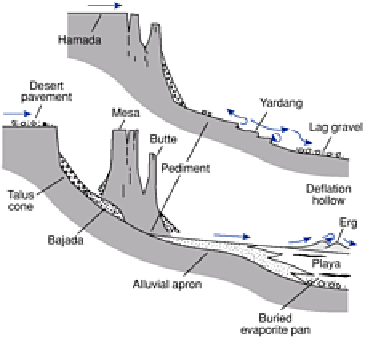Environmental Engineering Reference
In-Depth Information
of orthoclase feldspar in extreme cold in Siberia and Antarctica at temperatures below
−60° C. Rock structures and differential strength combine with air currents in all
environments to produce a series of fluted landforms, whose general orientation records
palaeocurrent directions.
AEOLIAN LANDSYSTEMS
Aeolian denudation occurs through mechanical weathering and rock slopes are cut back,
leaving residual
buttes
or
inselbergs
above low-angled
pediments
. Rapid evacuation of
debris by intense but ephemeral stream flow develops alluvial fans or
bajadas
across the
pediments and terminates in mud sheets or
playas
lining basin interiors (Figure 16.1 and
Plate 16.1). Ephemeral lakes add evaporites to the supply of deflatable material.
Denudation rates are high when there is syntectonic uplift or basin subsidence. Fluvial
facies die out and aeolian facies increase in abundance towards basin centres, where sand
seas dominate passive intercratonic basins. Wetter
pluvial
phases during the Quaternary
charged basins with fluvial sediments which are now deflating and the relatively slow
development of ergs has not yet obliterated the palaeofluvial landscape.
Figure 16.1
Stages in the development of a hot desert land-
system. Source: After Butzer (1976).
CLIMATE, TECTONICS AND DESERTS
systems
Aeolian environments cover 20 per cent of global land surfaces, associated with hot and
cold desert environments in zones of atmospheric subsidence and surface divergence,
with generally light winds. They are not found systematically in Earth's principal storm
and rain belts, which are also well vegetated. Large-scale atmospheric subsidence
provides a drying influence and blows out of continental interiors, isolating them from
maritime moisture sources Hot deserts are located beneath subtropical divergence on the





